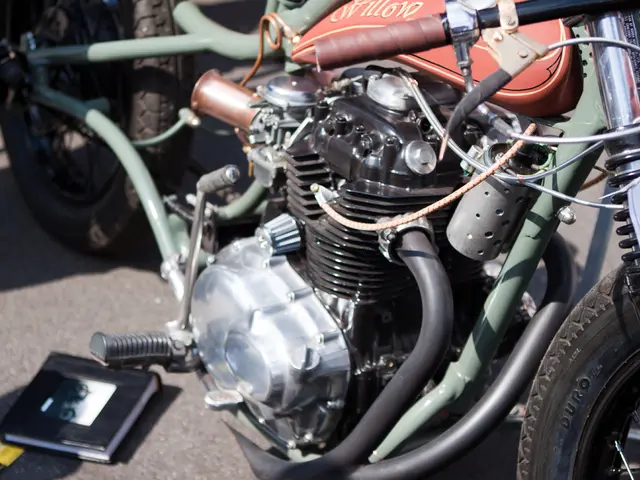Volkswagen's Latest EV MPV, ID.Buzz, Gets a Power Boost from Seven Up - Shedding Light on a Brighter Electrified Future for the Vehicle
Taking a Ride in Volkswagen's ID.Buzz: A Cult Classic in the Making?
Two years ago, I got my first taste of the long-awaited Volkswagen ID.Buzz, a vehicle that could potentially reclaim the spirit of the iconic Kombi or VW Type 2 Transporter. Electric and modernized, the hype surrounding the Buzz seemed unstoppable. But is this contemporary Kombi more of a cult hero than a blockbuster hit?
After driving the large, seven-seat version of the ID.Buzz, I've come to the conclusion that the original Buzz was brilliant, but the added practicality of this longer wheelbase model exposes its drawbacks even more prominently.
First, let's talk about aesthetics. The Buzz's design is still hard to fault. Drawing inspiration from the beloved '60s original and filtered through modern concept cars, the Buzz looks striking yet familiar. Despite the early success of design studies that were practically production-ready, they unfortunately never made it off the drawing board.
The ID.Buzz debuted in 2017, preserving much of the style and design ethos from production. Sitting atop Volkswagen's versatile MEB platform, shared with other ID cars, Skoda Enyaq, Elroq, Audi e-trons, Cupras, the Ford Capri, and more, the Buzz is the sole minibus model in this lineup.
Thanks to its unique layout, the Buzz provides ample interior space enhanced by clever design touches. The third row of seats offers generous legroom and can be flattened for a spacious boot, while the middle row slides back and forth for a more open cabin. Plus, all seats fold flat for transporting bulky items or transforming the Buzz into a makeshift bed. A panoramic roof infuses the cabin with sunlight and fresh air.
Driving the ID.Buzz Style variant, which features an 86kWh battery and 286 PS power output, left me with an overwhelmingly positive impression. While most EVs reward smooth, stately driving, the electric power gives the Buzz impressive overtaking capabilities. It's a far cry from the steering, brakes, and slow acceleration of its ancestors, all of which charmed owners back in the day.
Over three hundred miles, powered by a home charge and Instavolt's charging 'superhub' in Hampshire, the ID.Buzz never faltered, proving to be a reliable choice inside and out. Indeed, its refreshing road presence easily outshine comparable seven-seater SUVs, thanks in part to its attractive two-tone paint job (an optional extra) and a range of appealing pastel shades.
While the Buzz has won over critics and drawn a dedicated fanbase, its sales haven't set the world on fire. The US, a key market for the original T2, has not taken to the Buzz as expected. Lack of an official camper option is likely one culprit, but the car's main flaw is its range. Officially rated at 291 miles, the ID.Buzz's range pales in comparison to that of other similarly-sized electric vehicles, leaving it trailing in the fast-moving EV market.
Volkswagen has been producing the VW Bus for 75 years, since the launch of the Volkswagen Transporter in 1950. In conventional ICE format, the model is now known as the Multivan, supporting a diverse range of passenger cars, campers, and commercial vehicles. Although the Buzz doesn't have an official camper variant yet, it does offer itself as a stylish cargo-hauler for those needing work vans with a dash of panache. With a touch more range, the ID.Buzz would undoubtedly become a world-beater in the mini-van category.
Sign Up for Our Newsletter
Stay inspired, escape to another world, and immerse yourself in engaging design stories from across the globe. Subscribe now to have our daily dose of stimulation delivered straight to your inbox!
ID.Buzz, from £59,135 (as tested £64,345.00), Volkswagen-Vans.co.uk
Interesting Facts (optional):
- Volkswagen Australia delayed the introduction of the ID.Buzz to ensure that local customers received the latest technology available, potentially impacting initial sales momentum[1].
- The ID.Buzz operates in a niche market as the only all-electric passenger van, which may limit its appeal compared to more established categories like SUVs or traditional minivans. Despite being unique, it still faces competition from established electric vehicles and popular family vehicles[2][4].
- While the sporty GTX variant is expected to account for a significant portion of sales, the total volume might not yet match blockbuster levels. The GTX variant is anticipated to make up around 20% to 25% of total sales, subject to overall sales performance of the ID.Buzz[1].
- The ID.Buzz offers impressive cargo versatility, but its total cargo space is marginally less than that of traditional minivans when the third row is installed. However, removing the third row increases its cargo capacity significantly, although this requires extra storage space for the seats[4].
- The ID.Buzz's sales may be influenced by the adoption of electric vehicles in different regions. While the Buzz is well-suited for markets with robust charging infrastructure, it may face challenges in areas where EV adoption is slower[2].
- The ID.Buzz, Volkswagen's electric minibus, presents a blend of technology, finance, and lifestyle, aiming to reclaim the iconic status of the Kombi in the automotive industry.
- As the lone minibus model on Volkswagen's MEB platform, sharing it with vehicles like Audi e-trons and Skoda Enyaq, the ID.Buzz demonstrates the company's commitment to electric-vehicle production in the transportation sector.
- With a panoramic roof, versatile seating arrangements, and spacious interior, the ID.Buzz caters to the practical needs of a wide range of consumers, reflecting its promise as a car suited for both daily commutes and weekend adventures.
- Despite its intriguing design and impressive driving capabilities, the ID.Buzz struggles to maintain parity in the competitive electric-vehicle market due to its relatively limited range compared to competitors, which may impede its industry dominance.








